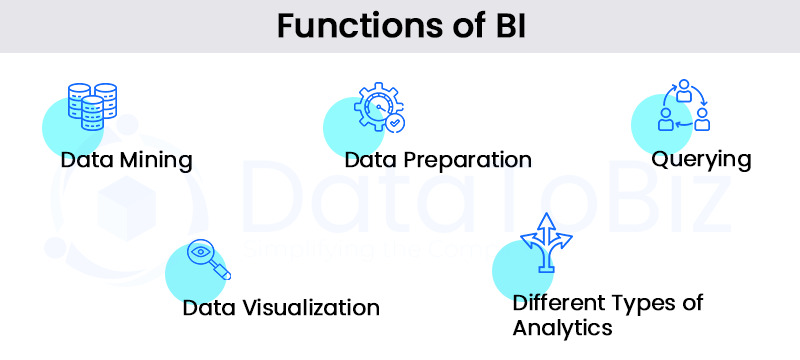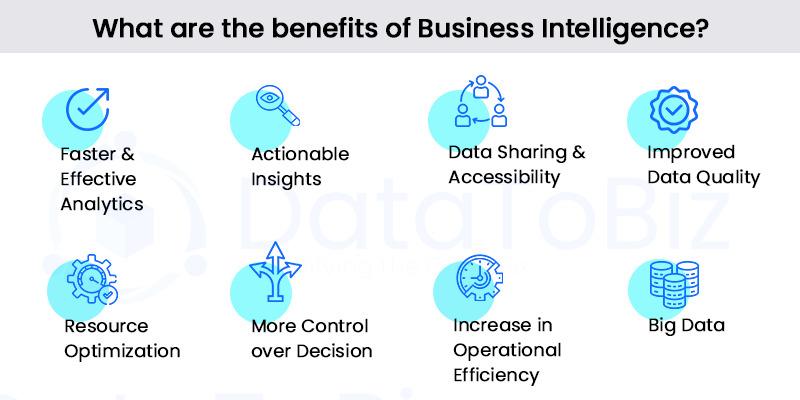MIS is a traditional information system used to collect and process data. BI is an umbrella term covering various processes and technologies that empower an enterprise to use data effectively and make the right decisions.
Before business intelligence took over, many enterprises had another information system called the MIS. Management Information Systems were the heart of every business and played a vital role in data collecting, storage, processing, and reporting. However, MIS had its disadvantages and became a burden for many businesses.
With business intelligence entering the market, enterprises adopted BI, not to replace MIS but to revamp their entire internal system. MIS is a small part of the business intelligence framework and is no longer enough in the competitive world to help establishments make the right decisions. Let’s read more about MIS and BI in detail and understand how BI is a better and more comprehensive alternative to traditional MIS.
MIS or Management Information System is based on an old concept where data is collected from various sources, compiled, and presented in a readable format. It is used by mid-level and top-level managers to make the necessary business decisions. MIS is a collection of systems and processes that facilitate data collection, compilation, and reporting within the enterprise.
The definition sounds similar to what a BI tool does. However, the difference lies in the technology used, the approaches to data collection, storage methods, and reporting formats. Before we read more about the differences, let’s take a brief look at the different functions of MIS.

Business intelligence or BI is a wider concept that combines MIS, business analytics, data mining, data visualization, and much more. It is a modern framework that helps enterprises adopt the data-driven model to make better decisions based on historical and real-time data. BI gives businesses a comprehensive view of the enterprise data and makes use of this information to understand market trends, improve customer experience, evaluate existing policies, and make changes to build a better enterprise.
Today’s BI tools and solutions offer self-service analysis to employees from different levels in the organization. Business intelligence tools are flexible, scalable, and user-friendly. Here’s what the BI framework handles in an enterprise:

MIS and BI are interrelated. They have common elements, though BI is an umbrella term that encompasses a range of processes and tools used to implement the data-driven model in an enterprise.
Management Information System or MIS is a part of the business intelligence framework. Traditionally, enterprises used MIS mainly for revenue and expense reporting. However, they had to face several issues with inaccuracies, inconsistent data, and other system complications. While business intelligence deals with the analysis of products and customers, MIS is used to analyze the business in terms of finances.
MIS delivers aggregate data reports which are not enough to get a complete picture of the business situation. It doesn’t offer in-depth insights that help the managers identify the problem. For example, the MIS report gives aggregate data about income and expenses. This doesn’t include transactional data that are key to identifying the root cause of the issue. The managers have to run multiple queries to gather the relevant information.
Business intelligence tools provide in-depth analytics for the given data. Moreover, the reports are generated in real-time. The dashboard of a BI tool allows employees to get a macro and micro view of the same report just with a few clicks. Business intelligence not only works faster but also requires lesser computing power as it has a higher processing capacity.
Business intelligence tools allow self-servicing within organizations by empowering employees to access data and run analytics as and when necessary. The dashboards can be accessed from different platforms such as web browsers and mobile apps. While MIS is complicated and confusing, BI is elaborate yet efficient and user-friendly. Automation is possible with business intelligence.
Management Information System has a narrow range of services, and business intelligence deals with a wider and broader scope where different aspects of the business are taken into consideration. Furthermore, BI is an advanced and modern framework that uses the latest technology to deliver accurate insights and reports. The disadvantages of MIS are solved using the BI tools.
Business intelligence gives organizations the necessary support to gain an edge over competitors by accurately analyzing market trends and customer preferences. From monitoring KPIs to customizing dashboards, BI helps businesses with the following aspects:

BI tools like Power BI and Tableau allow employees to generate real-time reports at any time. They can use existing templates or customize the dashboard to create detailed reports for the given parameters.
BI tools help track KPIs and understand the strengths and weaknesses of the business. The insights derived are quantifiable and can be used for better decision-making.
Struggling to reap the right kind of insights from your business data? Get expert tips, latest trends, insights, case studies, recommendations and more in your inbox.
BI tools are equipped to deal with large amounts of data from multiple sources. The vast amount of data in multiple formats can be easily processed by BI tools. BI tools are connected to data warehouses and data lakes with structured, semi-structured, and unstructured data to run analytics.
Business intelligence also improves the quality of data stored in the datasets. Analysis accuracy is highly dependent on the quality of the data used. BI tools get rid of inaccuracies and discrepancies by constantly processing data.
The insights derived through business intelligence help enterprises plan their production and marketing strategies with the utmost care. BI aims to provide a cost-effective solution while enhancing the quality of products and services. Automation saves resources by reducing the need for additional manpower to perform repetitive tasks.
Managers and C-level executives can use historical and real-time data to understand the exact situation before making decisions. BI tools can run predictive analytics and comparative analytics to provide detailed reports.
BI tools collect and store data in a centralized location, thus reducing the need to search for data on different systems across the enterprise. Employees can be more productive at work as they spend their working hours focusing on the core competencies of the business.
Employees from various organizational levels can access data through the BI dashboard. There’s no need for employees to send a request to the MIS team asking for certain information and wait until the team responds to the request. Real-time data is shared with all employees in the enterprise, and permissions are provided based on the job responsibilities.
Though management information systems are still used by enterprises, many have digitally transformed the systems and processes to get the best of business intelligence. BI helps enterprises reduce their costs and increase returns by enhancing customer experience and taking the businesses deeper into the market.
